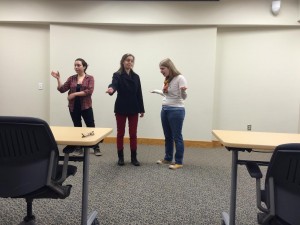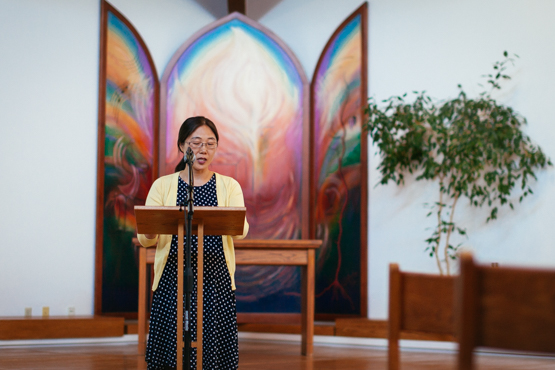Eastern Mennonite Seminary students present capstone projects that touched on both the personal formation experienced within the students’ seminary journey, and the transformation they hope to bring about as leaders in ministry. The capstone requirement helps seminarians synthesize and integrate into their unique ministry setting the four guiding curricular principles that have formed the rich foundation of their learning: wise interpretation, mature practice, discerning communication and transformational leadership.
“A culmination of their education, their capstone project is a reflection of their learning, a practical resource to carry with them into ministry, and often an exciting expression of creativity,” says seminary dean Michael A. King.
Seminary degrees were celebrated and conferred at baccalaureate and graduation May 30 and April 1, 2016.
Master of Divinity capstones
Candy Tharpe, “Grace Buddies: Integrating Children with Disabilities into the Church.” For her project, Tharpe initiated a program pairing volunteers with children who have disabilities in her congregation. In her presentation, she provided a historical overview of the church’s responses to people with disabilities over the centuries and highlighted scriptures that make the case for being attentive to opportunities for such ministry.
Maria Hosler Byler, “Written on our Hearts: Scripture memorization for the whole body.” Byler makes the case that “whenever we engage our bodies in the practice of scripture, bring it thoughtfully into conversation with our own story, and share it with others from the place of our own engagement, scripture can be transformational.” Her project involved her participation with Shenandoah Valley Biblical Storytellers as an experiment in one mode of engaging the biblical text.

Matthew Weaver, “Leadership in a Sea of Conflict.” Weaver describes the account of the conference held at Jerusalem and reported in Acts 15 as “a beautiful case study of a church in conflict.” The narrative “provides a window into the early church; it takes us to the debate floor of one of the most heated topics of the day.” Weaver compares being effective church leaders during times of unsettledness, to sailing a ship.
Lindsay Davis, “Playing with Parables: Using Theater to Embody the Parables of Jesus with Theater and Seminary Students.” Davis used theater to bring “nones” into conversation with congregation-attending young adults around the parables of Jesus. She observes, “Parables invite deeper reflection instead of clear-cut answers or distinctions. They are stories from the everyday with characters and a narrative, and as such, they can handle play.” She concludes that her “experiment should open doors to more discussion about doubt, questions, and creativity in the Church as a body.”
Larry Aikens, “Diverging Cultures: Yet a Coalescing Christ.” Aikens focuses on the impact of denominational diversity in American culture and in his own experience, citing the work of scholars who describe denominational identities in sociological terms. As a counterpoint to denominational diversity, he highlights unity in Christ, making “a case for denominational loyalty, yet a willingness to reach across denominational differences in order to cooperate around Christ’s missional work.”
Darin Busé, “Human Wholeness and the Dissociative Effects of Post-Combat Trauma.” In setting the backdrop for his project on post-traumatic stress disorder (PTSD) among military veterans, Busé explains that “because of the catastrophic magnitude of modern combat … military PTSD is especially wounding.” He proposes many combat veterans do not receive “the spiritually formative care that they so desperately need.”
Matthew Stearn, “Mennonites and Their Tools: Healing Communities for Combat Veterans.” Stearn makes the case that Mennonite communities are uniquely “poised to deal with the ‘broken hearts’ of returning combat veterans suffering from moral injury.” He distinguishes moral injury from PTSD, quoting an authority in the field to define moral injury as “perpetrating, failing to prevent, bearing witness to, or learning about acts that transgress deeply held moral beliefs and expectations.” Stearn elaborates on why and how Mennonites should offer redemptive responses to experiences of moral injury.
George Ryan, “Quo Vadis! Walking the Battlefield of PTSD in Faith with my Son.” Ryan writes that “the ministry concerns addressed in this project deal with the unknowing of God and the ministry response to evil and the enlightenment of the human consciousness to the love of God through great suffering.” The project draws on Ignatian Spirituality, Christian and Buddhist meditation, and philosophy. Ryan describes his journey with his son as “a spiritual journey; a journey of renewed suffering, rebirth and a journey of enlightenment that causes us to renew our minds, to be re-baptized.”
Mary Norville, “Looking for Midwives in a World of Privilege.” Norville’s project consisted of her writing a letter to her sons “that provided ways for them to identify racism while teaching them how to discern and develop healthy relationships.” Her social analysis spotlights entrenched racism and white privilege in American society and in the white church. As a corrective, she introduces the midwives of Exodus 1.15-21. She writes, “Shiphrah and Puah are the kind of people who represent a God-centered life in a world of privilege.” These midwives “were more afraid of being disobedient to God than they were of being disobedient to Pharaoh.”
Phil Kanagy, “Invitation to Hope: Pastoral Leadership in Anxious Times.” In his project, Kanagy outlines steps as a pastor to respond to anxieties about same-gender attractions and relationships. He explains that pastoral direction “in anxious times often means leading without clear maps.” Among his objectives is to direct anxious energies “in constructive ways rather than have them spiral in reactionary and destructive ways.” Another objective is “to educate, instruct, and edify the congregation.” Finally, he aims to nurture hope, believing “that anxious times hold not only the potential for fragmentation and destruction, but also the opportunity for creativity and renewal.”
Jeongih Han, “The Journey of Knowing God: God’s Grace in Suffering.” Han explores suffering as a common human experience and as a personal aspect of her own life. After describing the human longing and expectation for blessing she depicts the frequency of suffering and loss. She notes, “All humans once born must die.” Job provides examples both of experiencing loss and of remaining faithful to God. Han asks, “Are suffering and sadness more important than joy and happiness in our life?” She thinks yes, noting the importance of “how we think about suffering, trial, and troubles.”
Matthew Carlson, “Singing our Stories: Building Community through Shared Experience and Shared Expression.” Carlson designed a project of “setting music to a text that came directly from individuals’ narratives and then incorporating this new piece into a worship setting.” A musician and composer with experience in playback theater, he explains that the goal of the composition “is for the storyteller to experience their story in a new way, within the context of their faith community, and allow others in the community to share and respond musically to the individual’s story for the purpose of developing empathy and building community.”
Master of Arts in Church Leadership capstones
Kevin Lay, “Zeugnis in the Local Congregation through the Book of Ruth.” Lay applied Zeugnis, the practice of individuals other than the preacher engaging and expounding the Scripture. He led the congregation where he is pastor in experimenting with different practices of reading and discussing the book of Ruth. He translated and introduced biblical vocabulary – Mara and hesed – to his contemporary audience. And he invited guests who shed light on a contemporary issue – migration – to sensitize modern readers to the ancient biblical context.
Brian Martin, “Pastoring with a Christo-centric Theodicy in a Traumatized World.” Martin focused theological reflection on experiences of human trauma encountered as a pastor and as chaplain to a local police department. He highlighted the lament tradition in the Bible and teased out a non-triumphalistic view of Jesus’s healing ministry. Martin elaborated on his function in the chaplaincy as a model for his pastoral learnings – to represent God, speak little, and be comfortable with questions for which he does not have answers. The project involved teaching a class on theodicy in the congregation.
